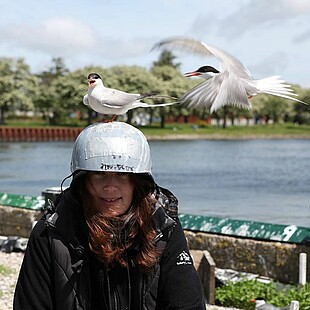Prof. Dr. Sandra Bouwhuis
Scientific director
Institute of Avian Research
An der Vogelwarte 21
26386 Wilhelmshaven
Germany
Tel.: +49 4421 9689 14
E-mail: sandra.bouwhuis@ifv-vogelwarte.de
Website: https://sites.google.com/site/drsandrabouwhuis/
Bluesky: https://bsky.app/profile/commonternproject.bsky.social
ORCID: 0000-0003-4023-1578
I am an evolutionary ecologist with a specific interest in the causes and consequences of within-individual change in life-history traits and between-individual variation in life-history strategies. I mostly conduct analyses on long- term individual-based datasets collected in wild populations, and have so far had the pleasure to work on great tits (Parus major), pre-industrial humans (Homo sapiens), jackdaws (Corvus monedula) and common terns (Sterna hirundo).
At the Institute of Avian Research, I maintain a long-term study population of common terns breeding at the Banter See in Wilhelmshaven. Using individual-based data collected longitudinally through the full lives of these birds, I ask and answer questions, such as:
* Do natal conditions affect the adult phenotype?
* How does the phenotype change with age or environmental variation (e.g. climate change, pollution, disease outbreaks)?
* Which physiological processes underlie such internally or externally induced plasticity?
* What is the (epi)genetic underpinning of key life-history traits and their plasticity?
* How does migration connect stages of the annual cycle and link in with fitness variation?
* How and when does selection occur, and on which traits or trait combinations does it act?
* Is there a response to selection and thus a change in the genotypic distribution in the population?
Although fundamental science is my trade, I also wish for this science to be communicated to interested members of the general public. As such, I collaborated with the city of Wilhelmshaven to, funded by the DBU and NBank, and making use of the artistic talents of Uwe Franzen and Dr Maria Röbbelen, design and establish an exhibition on common terns at the field station at the Banter See. This exhibition opened on the 12th of May 2023 and is now managed by the UNESCO-Weltnaturerbe Wattenmeer Besucherzentrum Wilhelmshaven. A mini-version of this exhibition has been developed as part of my ‘Suitcase Science’ project, such that I can visit schools to offer kids an interactive programme to learn about terns and how to study them.
Since 2019, I’m on the executive board of the NWDUG, a local association organising outreach events, such as Science Slam, Science Pub and the Long Night of Science. I also support the work of the Marschenrat, give lots of talks and tours, participate in interviews for radio items and newspaper articles, and contribute to documentaries and television programmes (e.g. BBC’s The One Show, NDR's ‘Unser Norden’, ARTE’s ‘Wild medicine’ and ‘Birds’, Friesischer Rundfunk’s daily news).
Finally, fundamental science is teaching us that many bird species are undergoing rapid declines. Using science to understand the reasons for these declines and to inform conservation projects has grown ever-closer to my heart. As such, I am very grateful to supplement the work of a conservation project protecting the last Central-European population of gull-billed terns (Gelochelidon nilotica) breeding at Neufelderkoog.


